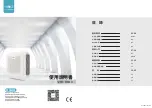
36
Installing and connecting the assembly pipe of the indoor unit
1. Cut out the appropriate knock-out piece (A, B, C) on the rear of the indoor
unit unless you connect the pipe directly from the rear.
2. Smooth the cut edges.
3. Remove the protection caps of the pipes and connect the assembly pipe
torque wrench, applying the following torque:
4.
5.
Then pull it out through the appropriate hole.
The pipe should not project from the rear of the indoor unit.
The bending radius should be 100 mm or more.
6. Pass the pipe through the hole in the wall.
7. For further details on how to connect to the outdoor unit and purge the air, refer to page 40.
refrigeration grade pipe only, (Cu DHP type according to ISO1337), degreased and deoxidized, suitable for operating pressures
of at least 4200 kPa and for burst pressure of at least 20700 kPa. Under no circumstances must sanitary type copper pipe be
used.
There are 2 refrigerant pipes of
diameters:
•
The smaller one is for the liquid refrigerant
•
The larger one is for the gas refrigerant
need to extend the pipe using the assembly pipe (optional).
The connection procedure for the refrigerant pipe varies
according to the exit position of the pipe when facing the wall:
•
Right(A)
•
Left(B)
•
Underside(C)
•
Rear
B
A
C
•
If you want to shorten or extend the pipes, refer to page 37~38.
•
Tighten the
nut with torque wrench according to
method.
•
DO NOT WALL UP THE PIPE CONNECTION !
All refrigerant pipe connection must be easy accessible and serviceable.
•
The pipe will be insulated and
permanently into position after
the installation and the gas leak test;
refer to page 44 for further details.
MAX_XSA_IBIM_DB98-33747A_E.pdf
Outer Diameter
Torque
N
•
m
(kgf
•
cm)
ø6.35 mm
14 ~ 18
140 ~ 180
ø9.52 mm
34 ~ 42
350 ~ 430
ø12.70 mm
49 ~ 61
500 ~ 620
ø15.88 mm
68 ~ 82
690 ~ 830













































